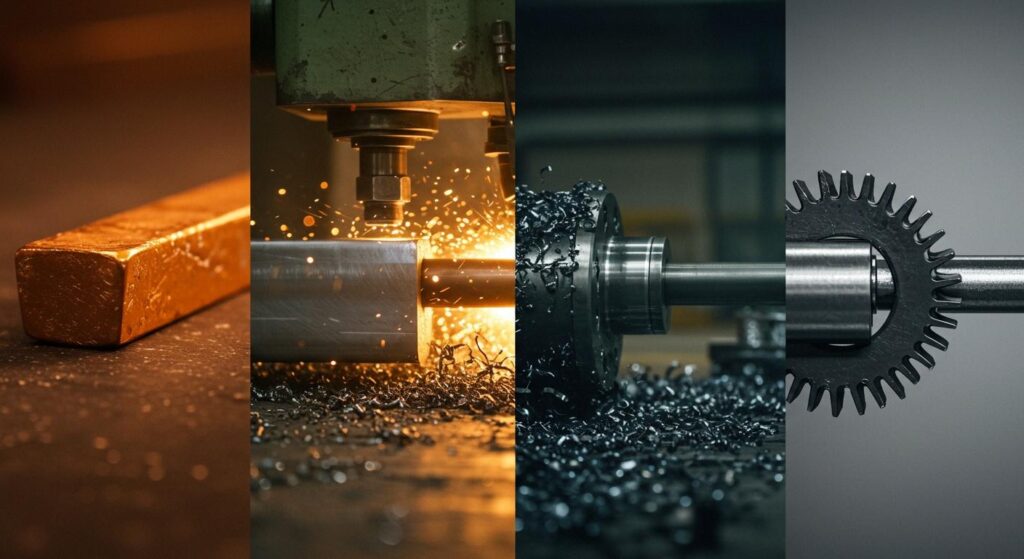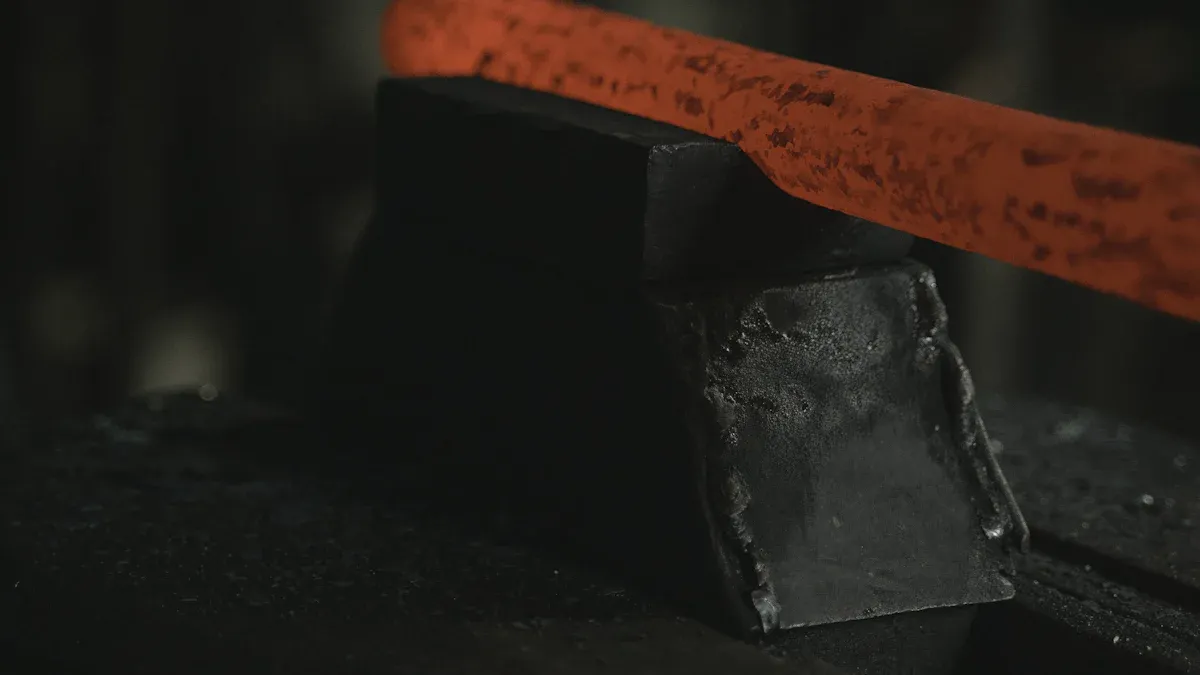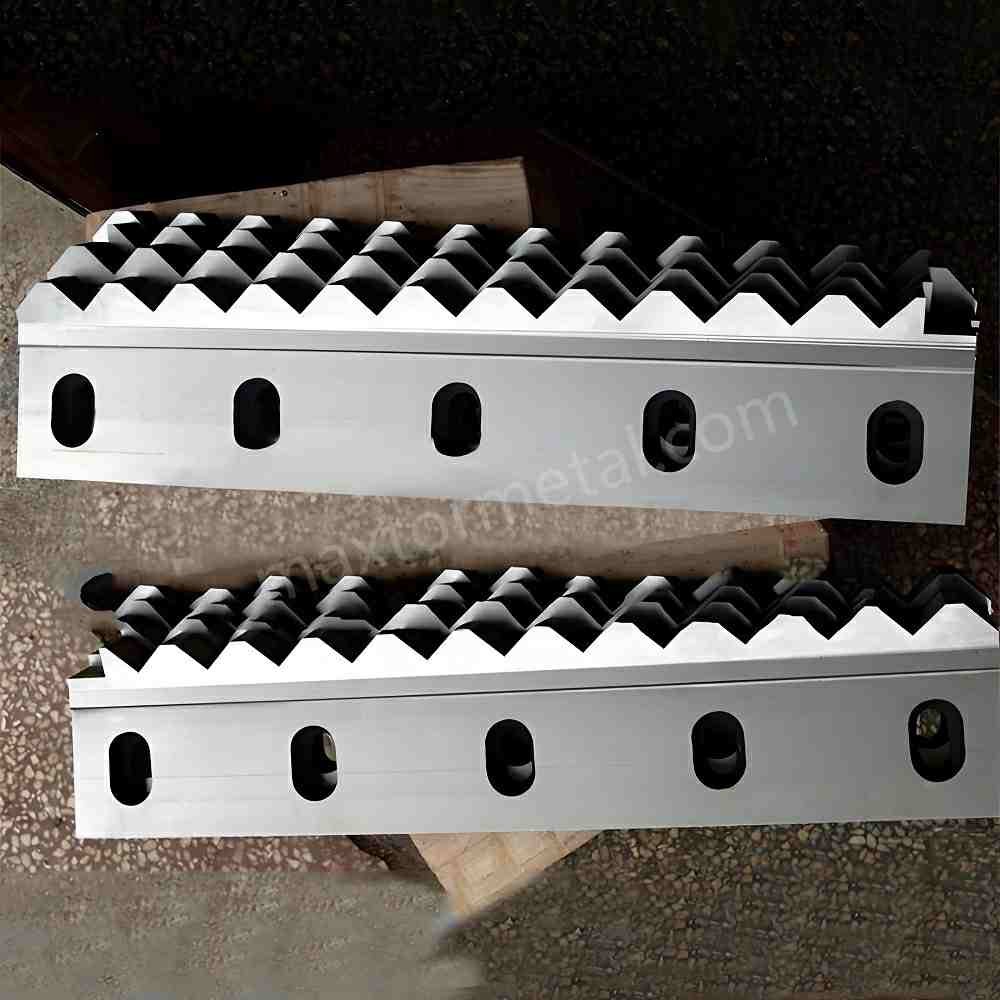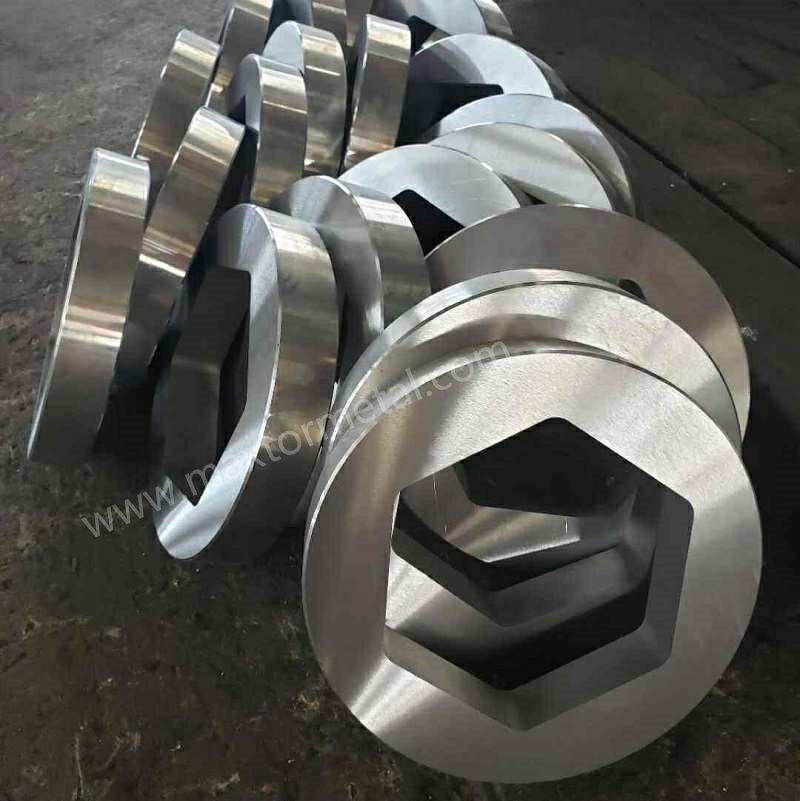
You watch raw steel change into a strong shredder blade through the meticulous Quy trình sản xuất lưỡi dao máy xé. This process begins with selecting the right material. Then, skilled workers shape the steel, heat it, and finish it. Each step—design, forming, hardening, polishing, and quality checking—enhances the blade’s strength and longevity. Suppliers utilize these steps to ensure shredders operate efficiently. Nam Kinh Metal allows customers to customize their needs and conducts thorough quality checks, making its blades exceptional.
Những điểm chính
- Picking the right steel is very important for shredder blades. It helps them last longer and work better.
- Good steps like rough grinding and careful heating help blades last longer.
- New methods like laser cutting and stamping make blades more exact and waste less material.
- Heat treatment steps, like hardening and tempering, make blades strong and tough.
- Precision machining makes sure blades are the right size and sharp. This is important for good shredding.
- Quality control checks at each step stop problems and make sure blades work well.
- Customization lets you change blades for special shredding jobs. This makes them work better.
- Picking a trusted supplier means you get blades that last longer and work better.
Lựa chọn vật liệu

Picking the right material is the first step. It is very important in making shredder blades. You must choose steel that fits your shredding job. The steel you pick affects how long the blade lasts. It also affects how well it works.
Steel Types for Shredder Blades
Many steel types are used in shredders. Each type has its own special features. The table below lists common steel types and what they offer:
| Loại thép | Mechanical Properties |
|---|---|
| Alloy Tool Steel (D2, M2) | Good strength, toughness, high hardness, and cutting performance. |
| Tungsten Carbide Alloy | Extreme hardness and wear resistance, ideal for hard and abrasive materials. |
| Martensitic Stainless Steel | Corrosion resistance and hardness, suitable for corrosive environments. |
| Thép tốc độ cao (HSS) | Excellent cutting performance and wear resistance for medium strength materials. |
| Ferritic Stainless Steel | Corrosion resistance, suitable for food processing and medical equipment. |
| Bột Metallurgy Thép | High hardness and uniform structure, preferred for high-strength and high-wear applications. |
Thép hợp kim
Alloy steel is strong and resists rust. It works well in wet or chemical places. This steel helps blades last longer. It also lets blades cut tough things.
Thép không gỉ
Stainless steel is hard and does not rust easily. Martensitic stainless steel is best for wet or rough places. Ferritic stainless steel is good for food or medical shredders.
Initial Inspection
You must check the steel before shaping it. Look for cracks or bad spots. Make sure the surface is even. Only the best steel goes to the next step. Skipping this check can make weak blades. Weak blades do not last long.
Preparation Steps
You must get the steel ready before making blades. The table below shows steps that help blades last longer:
| Preparation Step | Effect on Blade Longevity |
|---|---|
| Iron boriding surface treatment | Improves wear resistance significantly |
| Transition of wear mode | Reduces wear to a lower steady-state regime |
Follow these steps to help your blades:
- Rough grinding helps the blade have the right size. This step makes the blade work better and last longer.
- You must control heating and cooling during annealing. This stops uneven hardness and stress inside the blade. It also makes the blade stronger.
Note: Picking the right material and preparing it well helps make strong shredder blades.
Shredder Blade Processing

Blanking and Forging
Process Overview
First, workers shape raw steel into blade blanks. They use blanking to cut steel sheets into rough shapes. Heavy presses push down on the steel. This forms the basic outline of each blade. Workers watch the temperature closely. High heat makes the steel soft. Soft steel is easier to shape. They must check pressure and heat to stop cracks or weak spots. The goal is to make a blank that fits the design and size needed.
Nanjing Metal’s Advanced Forging Techniques
Nanjing Metal uses special forging machines. Sensors watch temperature and pressure all the time. This keeps each blade blank strong and the same. Custom dies let you pick different blade shapes. You can choose single-shaft, double-shaft, four-shaft, or claw designs. Each die matches the blade type you want. This way, blades are strong and last long. You get blades that work well for shredding.
Cắt Laser
Process Overview
After forging, laser cutting shapes the blade blanks. Powerful lasers cut steel with great accuracy. Computers control the cutting path. This step saves material and reduces waste. Blade blanks have exact sizes. The process is quick and clean. No chemicals or extra cleaning are needed. You save time and keep the area safe.
Here is a table showing how laser cutting helps:
| Lợi ích | Sự miêu tả |
|---|---|
| Superior accuracy and precision | Blades are cut to exact sizes. |
| Automated processes and minimized labor | Less human error, so sizes stay the same. |
| High-speed operations | More blades are made quickly. |
| Minimal post-processing requirements | Less waste and better use of steel. |
| Sự sạch sẽ | No chemicals needed, so cutting is cleaner. |
Nanjing Metal’s Laser Cutting Advantages
Nanjing Metal uses modern laser machines. You can ask for special blade shapes and tight sizes. The automated process keeps blade blanks the same every time. Blades fit your shredder just right. This technology lets you pick custom designs for different jobs.
Stamping Techniques
Process Overview
Stamping adds features to blade blanks. Machines punch holes and notches in the steel. You set the machines to repeat the same action. This step gives blades the right holes and edges. Results are always the same. Stamping is fast and uses steel well.
The table below shows the main advantages of stamping:
| Lợi thế | Sự miêu tả |
|---|---|
| High Material Utilization Rate | Uses steel well and makes less waste. |
| Tiết kiệm chi phí | Saves money and lowers production costs. |
Nanjing Metal’s Stamping Innovations
Nanjing Metal uses very accurate stamping dies. Automated checks find mistakes early. You get blades with the same features and fewer errors. This helps you get blades that work well in shredders. You can pick different blade types and sizes for your needs.
Forming Blade Blanks
Process Overview
You reach a key step when you form blade blanks. This step shapes the steel into the basic form of a shredder blade. Workers use machines to trim the edges and smooth the surfaces. They check the size and thickness to match the design. You see the blade start to look like its final shape. Edge profiling gives the blade its cutting angle. Surface smoothing removes rough spots. These steps help the blade fit well in the shredder and work with less friction. You get a blank that is ready for more finishing.
Tip: Careful shaping and smoothing at this stage help your shredder blade last longer and cut better.
Nanjing Metal’s Customization Capabilities
You may need a blade for a special job. Nanjing Metal can help you with that. The company uses advanced machines to make lưỡi dao tùy chỉnh blanks. You can choose the size, thickness, and edge style. If you need a blade for plastic, wood, or metal, you can ask for the right features. The team checks each blank to make sure it matches your order. You get a blade that fits your shredder and your needs. This level of customization supports many industries, from recycling to manufacturing.
- You pick the material and shape.
- You decide on the number of teeth or claws.
- You can request special holes or notches.
This process gives you more control over your shredding results.
Differences in Processing for Various Blade Types
Not all shredder blades are the same. Each type needs a different process. You see this in the way single-shaft, double-shaft, and claw-type blades are made. The table below shows some main differences:
| Loại máy hủy tài liệu | Loại lưỡi dao | Vật liệu sử dụng | Processing Capability |
|---|---|---|---|
| Trục đơn | Square Blade | Cr12MoV, D2, DC53 (HRC60°+) | Soft materials like plastics, wood |
| Double-Shaft | Claw Knife | 9CrSi, H13, D2, LD | General materials including plastics, wood, metals |
| Four-Shaft | Không có | Không có | Không có |
| Claw-Type | Claw Knife | Không có | Bulky waste, scrap metal, rubber, wood |
You notice that single-shaft shredders use square blades. These blades need strong steel and careful shaping for soft materials. Double-shaft shredders use claw knives. These need a different forging die and special edge work. Claw-type blades handle bulky waste. They need extra shaping and sometimes more teeth. Each type of blade blank goes through a unique process to match its job. This ensures your shredder works well for your material.
Xử lý nhiệt

Heat treatment is very important for shredder blades. It makes blades strong and tough. This process changes steel so it can handle hard jobs. There are three main steps: hardening, tempering, and stress relief. Each step helps the blade last longer and work better.
Làm cứng
Purpose and Process
Hardening is the first step. Workers heat the blade to very high temperatures. The steel changes inside and forms austenite. Then, they cool the blade quickly. This makes martensite, which is very hard.
Temperature Control and Quenching Methods
Workers must watch the temperature and cooling speed. The table below shows how different cooling methods change the blade:
| Môi trường làm nguội | Tốc độ làm mát | Tác dụng lên lưỡi dao |
|---|---|---|
| Nước | Rất nhanh | Highest hardness, more brittle |
| Dầu | Vừa phải | Cân bằng tốt giữa độ cứng và độ dẻo dai |
| Không khí | Chậm | Lower hardness, increased toughness |
Workers pick the best cooling method for each blade. Oil quenching gives a good mix of hard and tough. This helps blades last longer.
Impact on Blade Strength and Wear Resistance
Heat treatment makes blades harder and stronger. Blades keep their sharp edges longer. You do not need to sharpen them often. They can cut tough things like metal scraps and stones.
Nanjing Metal’s Advanced Hardening Techniques
Nanjing Metal uses special heat treatment steps. You get blades with high hardness (HRC 58-62). Workers control the temperature carefully. They use the right cooling method for each job. These steps help blades work well in tough places.
ủ
Purpose and Process
Tempering comes after hardening. Workers heat the blade again at a lower temperature. This step makes the blade less brittle and more bendable.
Temperature and Duration Optimization
Workers must choose the right temperature and time. If they temper too long, the blade gets soft. If they temper too short, the blade stays brittle. They use careful controls to get the best result.
Balancing Hardness and Toughness
Tempering helps blades be hard but not easy to break. This balance is needed for shredding many materials.
Nanjing Metal’s Tempering Innovations
Nanjing Metal uses modern ovens for tempering. You get blades with the right mix of hard and tough. Workers check each blade to make sure it is just right.
Stress Relief
Purpose and Process
Stress relief removes hidden stress inside the blade. This step stops the blade from bending or warping when used.
Methods for Reducing Internal Stresses
Workers use two main ways:
- Indirect aging: They machine the blade, then let it rest.
- Direct aging: They use heat or other methods to relax stress.
These ways help the blade keep its shape.
Enhancing Blade Stability and Longevity
Stress relief makes blades stable and long-lasting. Blades keep their size and work well in shredders.
Nanjing Metal’s Stress Relief Procedures
Nanjing Metal uses advanced stress relief steps. You get blades that meet design standards and work reliably.
Tip: Heat treatment is the secret to strong shredder blades. You get blades that last longer and work better for every shredding job.
Gia công chính xác

Precision machining shapes each shredder blade into its final form. The blade must have the right size and be very sharp. If there is a small mistake, shredding can go wrong. Nanjing Metal uses advanced machines to keep sizes almost the same. This makes sure every blade fits well and cuts quickly.
mài
Grinding is the first step in precision machining. Grinding makes the blade smooth and flat. It removes rough spots from earlier steps.
Surface Grinding
Surface grinding makes the blade flat and even. You put the blade blank on a magnetic table. The grinding wheel moves over the blade and takes off thin steel layers. This makes the blade the right thickness and smooth. A flat blade fits tightly in the shredder.
Edge Sharpening
Edge sharpening works on the blade’s cutting edge. Special grinding wheels make the edge sharp and exact. A sharp edge helps the blade cut tough things easily. It also lowers the chance of jams or bad cuts. Workers look at the edge with magnifiers to check if it is good.
Milling
Milling shapes the blade more. Computer machines cut grooves, slots, or special parts in the blade. Milling also makes the right angle for the cutting edge. This step is important for custom blade shapes. You can ask for special shapes or features for your job.
Note: Grinding and milling keep the blade size very close to the plan. This means every blade works the same way each time.
Here is a table showing typical tolerances for shredder blades in different industries:
| Ngành công nghiệp | Dung sai khuyến nghị | Tại sao nó quan trọng |
|---|---|---|
| Bao bì | ±0,05mm | Cho phép xử lý tốc độ cao |
| Chế biến gỗ | ±0,10mm | Provides flexibility for materials |
Small tolerances help the blade fit and work better. High precision means less shaking and smoother shredding.
hoàn thiện
Finishing is the last step in precision machining. You polish the blade to remove tiny burrs or sharp edges. This step also makes the blade look better and stops rust. Workers check each blade for size, shape, and sharpness. Only good blades go to the next stage.
- You get blades with almost no size mistakes.
- You receive blades that are sharp and ready for hard jobs.
Tip: Precision machining helps your shredder blades last longer and work better.
Shredder Blade Manufacturing Process Quality Control

Quality control is very important when making shredder blades. It helps make sure every blade is safe and lasts long. Nanjing Metal checks each blade many times. These checks help stop problems before they start. They also keep your shredder working well.
Điều tra
First, workers look at each blade closely. They search for cracks or rough spots. They use calipers and gauges to measure size. Workers check if the blade is sharp and straight. If a blade is not right, it does not move on. This step finds mistakes early and saves time later.
- Looking at the blade finds surface problems.
- Measuring tools check the blade’s size and shape.
- Checking the edge makes sure it can cut well.
Tip: Checking early helps you save money and keeps your shredder safe.
Kiểm tra hiệu suất
You need to know if a blade works well before using it. Workers test how strong and sharp the blade is. They use the blade to cut different things. They see how long the blade stays sharp. They also check how much force is needed to cut.
Testing follows rules from around the world. These rules help keep people and the environment safe. You see rules from ISO, CE, and REACH in Europe. North America and Asia have their own safety rules. Following these rules takes more time and money. But it helps stop fires or injuries.
- Safety and environmental rules are important.
- Tests use plastics, metals, and rubber.
- Results show if the blade meets world standards.
Note: Following these rules keeps you and your team safe from blade problems.
Defect Checks
After testing, workers check for defects again. They use machines and their eyes to find hidden cracks. They look for problems like warping or uneven hardness. If they find a problem, they take out the blade.
| Defect Type | How You Detect It | Tại sao nó quan trọng |
|---|---|---|
| Các vết nứt | Visual and ultrasonic | Stops sudden breaks |
| Cong vênh | Measurement tools | Makes sure it fits right |
| Độ cứng không đồng đều | Hardness testers | Helps blade last longer |
You want blades that pass all the checks. This helps you get blades you can trust for your shredder.
Tip: Careful checks help you avoid stopping work and keep your shredder running well.
Final Assembly

Blade Assembly
You reach the final stage when you assemble the shredder blade. Workers fit each blade into its mounting position. They use special tools to make sure the blade sits tight and straight. You see them check the alignment and spacing. This step helps the blade work smoothly inside the shredder. If you need a custom solution, Nanjing Metal offers OEM and ODM services. You can ask for blades that match your machine or special requirements. The team can adjust the blade shape, size, or mounting holes for your needs.
Quality control plays a big role during assembly. Workers use a spectrum analyzer to confirm the steel type. They check for cracks with ultrasonic flaw detection. You see them measure the blade’s size and test its hardness. The table below shows some of the main quality control steps:
| Biện pháp kiểm soát chất lượng | Sự miêu tả |
|---|---|
| Material Inspection | Spectrum analyzer checks steel type. |
| Internal Structure Checks | Ultrasonic flaw detection finds cracks. |
| Comprehensive Quality Inspection | Workers measure size, test hardness, and inspect structure. |
Tip: Careful assembly and inspection help your shredder blade last longer and work better.
Lớp phủ
After assembly, workers apply a protective coating. This layer helps stop rust and wear. You can choose different coatings for your blade. Some coatings resist chemicals. Others help the blade stay sharp longer. The coating also makes the blade easier to clean. If you need a special coating for your job, you can ask for it. Nanjing Metal can provide coatings that fit your needs, whether you shred plastic, wood, or metal.
Workers check the coating for even coverage. They look for missed spots or bubbles. A good coating helps the blade last longer in tough conditions.
Bao bì
Once the blade is ready, workers package it for shipping. They wrap each blade to protect it from scratches. You see labels on each package. The label shows the blade type, size, and order number. Workers include documents that list the blade’s features and inspection results. This helps you check the blade when it arrives.
If you order from Nanjing Metal, you get help with the import process. The team prepares all the paperwork you need. You receive blades that are ready to use in your shredder. The packaging keeps the blade safe during transport. You can trust that your blade will arrive in good condition.
Note: Proper packaging and documentation make it easy for you to track your order and start using your new blade right away.
Evaluating Shredder Blades for Equipment Suppliers

Picking the right shredder blade is very important. It helps your equipment work well and helps your business succeed. If you are a supplier, you need to know what to check when looking at blades and companies. This part will show you the main things to look for, why it is good to have blades that are always the same, and what good suppliers do.
Key Quality Indicators
You should look at a few main things before picking a blade. These things help you see if the blade will work for you and last a long time. The table below lists the most important things to check:
| Chỉ số | Sự miêu tả |
|---|---|
| Loại vật liệu | The kind of steel or alloy, like hardened or coated steel, changes how long the blade lasts. |
| Cutting Technology | The way the blade cuts should match what you need to shred. |
| Yêu cầu bảo trì | Blades that are easy to clean and fix work better for longer. |
| Throughput Capacity | The blade should handle the amount you need to shred each hour. |
| Các tính năng an toàn | Look for things like guards and emergency stops to keep people safe. |
| Hiệu suất năng lượng | Blades that use less energy help you save money. |
| Độ bền và tuổi thọ | Good materials and strong build mean the blade will last longer. |
Tip: Always pick a blade with the right material and cutting style for your waste. This helps you get better results and keeps the blade from wearing out too soon.
Sự nhất quán
Blades made the same way every time help your shredder work better. When you use blades with high standards, you get better cuts and fewer problems. Here are some reasons why it is important:
- Good blades keep cutting well, so your shredder runs smoothly.
- Blades that are always the same do not need to be changed as much, so you save money.
- Strong blades mean your team can work more without stopping for repairs.
- Blades made from tough materials last longer and do not wear out fast, which saves you money.
You should check if the company uses good machines and checks each blade carefully. This helps you get blades that work the same way every time.
Supplier Practices
The best suppliers do things to make sure you get good blades and service. When you pick a supplier, look for these things:
- They spend money on new ideas to make blades better and more efficient.
- They use good materials and test each blade to make sure it is strong and sharp.
- They care about the environment by making less waste and saving energy.
- They help you with support and fixing so you can use the blades for a long time.
Nam Kinh Metal is special because it has over 3,000 blade types for many jobs. The company uses modern machines and strong tests to make sure each blade lasts longer than most others. You can also ask for special blades to fit your needs, which helps your business do better.
Note: If you pick a supplier who does these things, you get blades that help your shredder work better and save you money over time.
You can watch how each part of making shredder blades is important. Picking good materials, making blades carefully, and checking quality help your shredder work well. Every step helps the blade be strong and last a long time.
- The blades stay sharp longer and make cleaner cuts.
- You can count on the shredder blade manufacturing process to give good results.
Want to know more or get a price? Liên hệ với nhóm của chúng tôi for help from experts.
Câu hỏi thường gặp
What materials do you use for shredder blades?
Manufacturers use alloy steel, stainless steel, and tool steel. These materials make blades strong and help them cut well. You can pick the best material for your shredding job.
How do you keep shredder blades sharp?
Grinding and milling machines sharpen the blades. Workers look at the edge with magnifiers. Sharpening often keeps blades working their best.
Can you customize shredder blades for my machine?
You can ask for special blade shapes, sizes, and features. Advanced machines help match blades to your shredder. You get blades that fit your machine just right.
How do you test the quality of shredder blades?
Workers check blades for cracks and measure their size. They test blades by cutting different things. Quality checks make sure you get blades you can trust.
What coatings are available for shredder blades?
You can pick coatings that stop rust, chemicals, or wear. These coatings help blades last longer and make cleaning simple.
How do you package shredder blades for shipping?
Blades are wrapped to stop scratches. Each package has labels and papers. Good packaging keeps blades safe while shipping.
How often should you replace shredder blades?
Replace blades when they get dull or do not cut well. Checking often helps you know when to get new blades.
Tip: Always follow the maker’s rules for blade care and replacement. This keeps your shredder safe and working well.
Xem thêm
Tối Đa Hóa Doanh Thu Từ Rác Thải Gỗ với Dao Máy Xé Gỗ Hiệu Suất Cao
Các Tính Năng Thiết Yếu của Lưỡi Dao Máy Xé Rác Điện Tử để Tiêu Hủy An Toàn
Cách Chọn Lưỡi Dao Máy Xé Nhựa để Tái Chế Hiệu Quả
Hướng Dẫn Toàn Diện về Thiết Kế Lưỡi Dao Máy Xé Trục Đơn
Lưỡi máy hủy tài liệu: Phân tích phân loại, lựa chọn vật liệu, tuổi thọ sử dụng và kỹ thuật thiết kế


